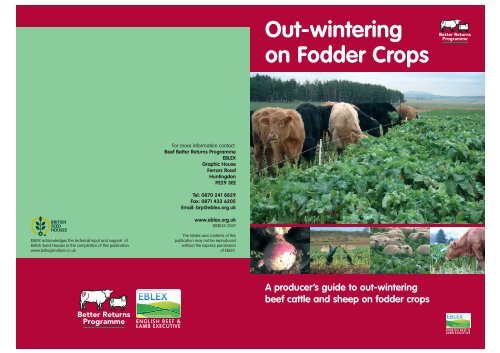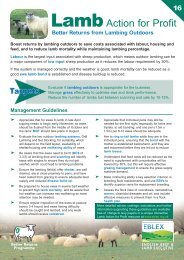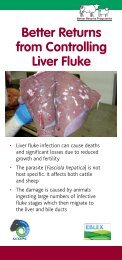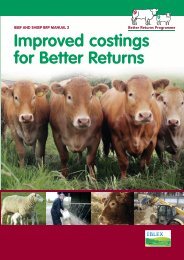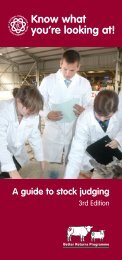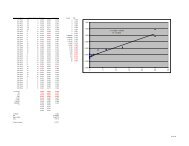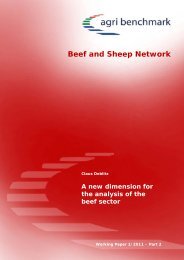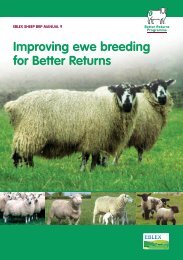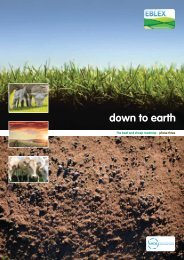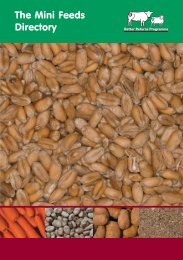You also want an ePaper? Increase the reach of your titles
YUMPU automatically turns print PDFs into web optimized ePapers that Google loves.
EBLEX acknowledges the technical input and support of<br />
British Seed Houses in the compilati<strong>on</strong> of this publicati<strong>on</strong>.<br />
www.bshagriculture.co.uk<br />
For more informati<strong>on</strong> c<strong>on</strong>tact:<br />
Beef Better Returns Programme<br />
EBLEX<br />
Graphic House<br />
Ferrars Road<br />
Huntingd<strong>on</strong><br />
PE29 3EE<br />
Tel: 0870 241 8829<br />
Fax: 0871 433 6205<br />
Email: brp@eblex.org.uk<br />
www.eblex.org.uk<br />
©EBLEX 2007<br />
The tables and c<strong>on</strong>tents of this<br />
publicati<strong>on</strong> may not be reproduced<br />
without the express permissi<strong>on</strong><br />
of EBLEX.<br />
<str<strong>on</strong>g>Out</str<strong>on</strong>g>-<str<strong>on</strong>g>wintering</str<strong>on</strong>g><br />
<strong>on</strong> <strong>Fodder</strong> <strong>Crops</strong><br />
A producer’s guide to out-<str<strong>on</strong>g>wintering</str<strong>on</strong>g><br />
beef cattle and sheep <strong>on</strong> fodder crops
The technical informati<strong>on</strong> in this booklet was supplied by<br />
British Seed Houses, Milk Development Council (MDC),<br />
Scottish Agricultural College (SAC) and Quality Meat<br />
Scotland (QMS) and compiled by Dr Mary Vickers, MLC.<br />
Edited Matt Mellor, ABC<br />
For more informati<strong>on</strong> c<strong>on</strong>tact:<br />
Beef Better Returns Programme<br />
EBLEX<br />
Graphic House, Ferrars Road<br />
Huntingd<strong>on</strong>, PE29 3EE<br />
Tel: 0870 241 8829<br />
Fax: 0871 433 6205<br />
Email: brp@eblex.org.uk<br />
www.eblex.org.uk<br />
While the authors have worked <strong>on</strong> the<br />
best informati<strong>on</strong> available to them,<br />
neither the <strong>Eblex</strong> Better Returns<br />
Programme, nor the authors shall in<br />
any event be liable for any loss,<br />
damage or injury howsoever in relati<strong>on</strong><br />
to the booklet or the informati<strong>on</strong> <strong>on</strong><br />
which it is based.<br />
Reference herein to trade names and<br />
proprietary products and services<br />
without stating that they are protected<br />
does not imply that they may be<br />
regarded as unprotected and thus free<br />
for general use. No endorsement of<br />
named products or services is<br />
intended nor any criticism implied of<br />
other alternative but unnamed<br />
products.<br />
Delivered by<br />
<str<strong>on</strong>g>Out</str<strong>on</strong>g>-<str<strong>on</strong>g>wintering</str<strong>on</strong>g><br />
<strong>on</strong> <strong>Fodder</strong><br />
<strong>Crops</strong><br />
C<strong>on</strong>tents<br />
• The benefits of out-<str<strong>on</strong>g>wintering</str<strong>on</strong>g> for<br />
beef and sheep producers 4<br />
• <strong>Fodder</strong> crop selecti<strong>on</strong> 5<br />
• Growing and managing the<br />
crop pre-grazing 8<br />
• Crop utilisati<strong>on</strong> 10<br />
• Performance and financial<br />
implicati<strong>on</strong>s 16
The benefits of<br />
out-<str<strong>on</strong>g>wintering</str<strong>on</strong>g> for beef<br />
and sheep producers<br />
Brassica fodder crops such as kale, forage<br />
rape, grazing turnips, stubble turnips, swedes<br />
and new rape/kale hybrids offer beef and<br />
sheep producers the opportunity to:<br />
• reduce feed costs;<br />
• reduce winter housing costs;<br />
• reduce labour and machinery<br />
requirements for feeding;<br />
• reduce machinery costs associated with<br />
silage making and manure handling;<br />
• reduce fuel use and the carb<strong>on</strong> footprint;<br />
• reduce exposure to forage shortages<br />
caused by drought;<br />
• enhance low input systems;<br />
• increase output per unit of land;<br />
• avoid housing-related health issues;<br />
• expand producti<strong>on</strong> without additi<strong>on</strong>al<br />
capital cost;<br />
• extend the grazing seas<strong>on</strong>;<br />
• grow an alternative break crop in arable<br />
and grazing rotati<strong>on</strong>s;<br />
• initiate alternative cropping in<br />
uncultivated areas without<br />
ploughing (using brassicas<br />
as a pi<strong>on</strong>eer crop);<br />
• produce high DM yield<br />
in short growing seas<strong>on</strong>s;<br />
• provide a valuable break<br />
before pasture renewal.<br />
4<br />
Crop selecti<strong>on</strong><br />
Feed budgeting<br />
The first step in the planning of any out<str<strong>on</strong>g>wintering</str<strong>on</strong>g><br />
system is feed budgeting. Taking a<br />
whole-farm approach, c<strong>on</strong>sider the following<br />
points:<br />
1. What are my total feed requirements for<br />
the stock being held <strong>on</strong> the farm?<br />
2. How are these feed requirements met<br />
under my current system?<br />
3. What opportunities are offered by out<str<strong>on</strong>g>wintering</str<strong>on</strong>g>?<br />
4. How much feed do I want from my out<str<strong>on</strong>g>wintering</str<strong>on</strong>g><br />
system in order to exploit these<br />
opportunities?<br />
Which crops will meet my requirements?<br />
Having established your feed requirements<br />
from out-<str<strong>on</strong>g>wintering</str<strong>on</strong>g>, you can choose the<br />
appropriate cropping system, which will<br />
depend <strong>on</strong>:<br />
1. When you want to use the crop.<br />
2. The number and type of stock required to<br />
feed.<br />
3. When the land intended for growing the<br />
crop becomes vacant.<br />
5
GUIDELINES FOR SOWING AND FEEDING (BEEF AND SHEEP) SUITABILITY FOR DIFFERENT TYPES OF LIVESTOCK<br />
Brassica fodder crops offer a flexible feeding opti<strong>on</strong> for livestock farmers, with the range of<br />
sowing and feeding dates summarised in the table below. In some cases (e.g. some varieties of<br />
grazing turnips and new rape/kale hybrids) crops can offer multiple grazing opportunities when<br />
drilled early in the summer and managed appropriately.<br />
<strong>Fodder</strong> Sowing<br />
Beet Feeding<br />
Swedes Sowing<br />
Feeding<br />
Kale Sowing<br />
Feeding<br />
Turnips Sowing<br />
Feeding<br />
Stubble Sowing<br />
Turnips Feeding<br />
Grazing Sowing<br />
Turnips Feeding<br />
Rape/kale Sowing<br />
hybrid Feeding<br />
Forage Sowing<br />
Rape Feeding<br />
The most suitable brassicas for grazing during<br />
the winter m<strong>on</strong>ths are kale, swedes and certain<br />
multigraze rape/kale hybrids. Stubble turnips,<br />
grazing turnips and forage rape are less winter<br />
hardy but are ideal for extending the grazing<br />
seas<strong>on</strong> to the end of the year. Many crops can<br />
Jan Feb Mar Apr May Jun Jul Aug Sep Oct Nov Dec<br />
6<br />
also be used as catch crops for grazing during<br />
mid or late summer when other forage<br />
availability can be short, e.g. stubble turnips,<br />
kale and certain rape/kale hybrids. <strong>Fodder</strong><br />
beet is a higher input crop and is typically<br />
lifted (as opposed to being grazed in the field).<br />
Brassica fodder crops including kale, grazing<br />
turnips, stubble turnips, and recently<br />
introduced rape/kale hybrids are generally<br />
suitable for feeding to all classes of beef cattle<br />
and sheep. Swedes have more limited<br />
potential, being recommended <strong>on</strong>ly for cattle<br />
with fully mature teeth and not being suitable<br />
for broken mouthed sheep.<br />
Breeding cows in late pregnancy should ideally<br />
not be grazed <strong>on</strong> brassicas, to avoid the risk of<br />
calving in an unsuitable envir<strong>on</strong>ment.<br />
Varietal choice<br />
There is c<strong>on</strong>siderable variati<strong>on</strong> in performance<br />
between different varieties so be sure to ask<br />
questi<strong>on</strong>s about:<br />
• yield (and specifically usable yield);<br />
• disease resistance;<br />
• digestibility of stems/bulbs/leaves;<br />
• leaf-to-stem ratio;<br />
• regrowth ability;<br />
• winter hardiness;<br />
• growing height;<br />
• versatility.<br />
7
Growing and managing<br />
the crop pre-grazing<br />
Independent trials at SAC have shown that<br />
provided a proper field risk assessment is<br />
combined with good agr<strong>on</strong>omic and grazing<br />
management out-<str<strong>on</strong>g>wintering</str<strong>on</strong>g> can be successful<br />
<strong>on</strong> many farms.<br />
Field choice and preparati<strong>on</strong><br />
• Choose fields where grass producti<strong>on</strong> is<br />
falling.<br />
• The soil must be free draining and dry<br />
out quickly.<br />
• Ideal sites offer shelter for livestock, but<br />
have sufficient air flow to allow fields to<br />
dry out.<br />
• Avoid steeply sloping fields or those<br />
close to water courses or water supplies.<br />
• Soil test 8 weeks prior to sowing.<br />
• Soil pH should be at least 5.6 (optimum<br />
5.8-6.5).<br />
• Apply fertiliser and lime according to soil<br />
test results.<br />
• C<strong>on</strong>trol weeds prior to sowing.<br />
To minimise disease risks brassica crops<br />
should not be c<strong>on</strong>tinuously grown <strong>on</strong> the same<br />
area. A gap of 4-5 years (drier areas of the UK)<br />
or 7-8 years (wetter areas) between crops is<br />
advised.<br />
8<br />
Envir<strong>on</strong>mental impact<br />
Careful field selecti<strong>on</strong> is crucial to minimise the<br />
risk of soil poaching and runoff.<br />
Fields with sandy soils, good soil drainage<br />
characteristics and gentle slopes are<br />
preferable to heavy clay soils which are poorly<br />
drained or steep slopes where c<strong>on</strong>siderable<br />
runoff can occur leading to soil erosi<strong>on</strong><br />
problems. Fields should not be near<br />
watercourses.<br />
Providing a dry area of run-back (a loafing or<br />
grazing area at <strong>on</strong>e end of the field where<br />
stock may find shelter) is recommended. Avoid<br />
vehicles travelling in the field during the winter<br />
by putting bales out in the summer. Organise<br />
feed fences to provide maximum fr<strong>on</strong>tage and<br />
a narrow strip of accessible fodder, and avoid<br />
overstocking. Finally c<strong>on</strong>sider reduced tillage<br />
techniques for establishment.<br />
Sowing<br />
Earlier sowing leads to higher yields in both<br />
root and leafy brassicas crops, but remember<br />
that crops can become less digestible as they<br />
mature (with utilisati<strong>on</strong> falling) if they are sown<br />
too early for the planned grazing period.<br />
Seed can be broadcast or drilled into a<br />
cultivated seedbed but where c<strong>on</strong>diti<strong>on</strong>s are<br />
good can be direct drilled. Kill off any existing<br />
swards with glyphosate. Direct drilling<br />
improves the retenti<strong>on</strong> of soil moisture and<br />
produces a firmer surface for grazing that is<br />
less pr<strong>on</strong>e to poaching compared to fields that<br />
are ploughed and then<br />
drilled. <strong>Crops</strong> should<br />
be direct drilled<br />
into clean, open<br />
ground to aid<br />
germinati<strong>on</strong>.<br />
Sow seeds<br />
to a maximum<br />
depth of 10mm<br />
to ensure uniform<br />
germinati<strong>on</strong>. Roll the<br />
field after sowing.<br />
Pest c<strong>on</strong>trol<br />
It can be a wise investment to use treated<br />
seed to protect seedlings again insect attack.<br />
Comm<strong>on</strong> pests include flea beetle, diam<strong>on</strong>d<br />
back moth and slugs and it is important to<br />
m<strong>on</strong>itor crops closely throughout. C<strong>on</strong>trol is<br />
usually most cost effective if the potential<br />
problem is spotted early. Seek advice from a<br />
qualified agr<strong>on</strong>omist at the earliest opportunity<br />
and take prompt acti<strong>on</strong>.<br />
Weed c<strong>on</strong>trol should be carried out in the<br />
previous crop, or through the use of a preemergence<br />
herbicide after drilling.<br />
Fertiliser<br />
Brassica fodder crops resp<strong>on</strong>d well to good soil<br />
fertility and are particularly resp<strong>on</strong>sive to nitrogen<br />
(N) and phosphorus (P).<br />
Soils must always be tested as part of the<br />
planning stage, and where indices for N, P and K<br />
(potash) are 0 or 1, a cost effective resp<strong>on</strong>se will<br />
be achieved from fertiliser applicati<strong>on</strong>s. Seek<br />
advice from a FACTS qualified adviser, using RB<br />
209 as a guide, however the following table is<br />
included as an indicati<strong>on</strong> of a typical applicati<strong>on</strong><br />
regime.<br />
EXAMPLE FERTILISER APPLICATION RATES AND TIMINGS FOR DIFFERENT CROPS<br />
CROP Nitrogen Phosphate Potash N applied N applied<br />
kg/ha P20 5 kg/ha K 20 kg/ha at sowing later<br />
(units/acre) (units/acre) (units/acre) (% of total) (% of total)<br />
Swedes 75-100 75-100 75-100 50% 50% at<br />
(60-80) (60-80) (60-80) 10-12 weeks<br />
Kale 100-120 80 (65) 80 (65) 50% 50% at<br />
(80-96) 10-12 weeks<br />
Stubble turnips 80-120 70 (55) 70 (55) 60% 40% at<br />
(64-96) 6-8 weeks<br />
Grazing turnips 40-60 30-40 30-40 100% Further N may<br />
(32-48) (24-32) (24-32) be applied<br />
for regrowth<br />
Forage rape 50-80 40-60 40-60 100% Further N may<br />
or rape/kale (40-64) (32-48) (32-48) be applied<br />
hybrid for regrowth<br />
Source: British Seed Houses<br />
9<br />
Seed treatment can protect brassicas against diseases such<br />
as Alternaria (shown) in the first few weeks.<br />
A trial plot of kale showing benefits of seed treatment (left)<br />
compared with untreated seed.
Crop utilisati<strong>on</strong> & feeding<br />
management<br />
Some nutriti<strong>on</strong>ists recommend that brassicas<br />
should not make up more than 50% of dry<br />
matter intake but farmer<br />
experience suggests<br />
that up to 70%<br />
inclusi<strong>on</strong> can be<br />
achieved<br />
successfully.<br />
Brassicas<br />
should always<br />
be fed with ad<br />
libitum fibrous<br />
forage (straw,<br />
silage, hay) to<br />
improve the<br />
“scratch factor” in<br />
the rumen.<br />
Overfeeding can lead to<br />
reduced intake and<br />
performance, with health problems such as<br />
iodine deficiency (goitre) and anaemia<br />
becoming a risk.<br />
<str<strong>on</strong>g>Out</str<strong>on</strong>g>-wintered cattle have a higher energy<br />
requirement compared with those housed<br />
indoors and at least 15% more feed energy<br />
may be required.<br />
10<br />
Strip grazing<br />
The key to success with grazing fodder crops<br />
is strip grazing using an electric fence to<br />
maximise crop utilisati<strong>on</strong> and minimise<br />
wastage. Each strip (break) should be l<strong>on</strong>g<br />
and narrow to allow all the animals to access<br />
the crop at <strong>on</strong>ce. The fence should ideally be<br />
moved daily, with the area provided being<br />
determined using the calculati<strong>on</strong> explained <strong>on</strong><br />
page 15.<br />
Introduce stock to the crop slowly <strong>on</strong> full<br />
stomachs to avoid digestive upsets. Start by<br />
allowing the stock access to the crop for 1-2<br />
hours a day, building up to unrestricted access<br />
after 7-10 days.<br />
It is str<strong>on</strong>gly recommended that a wide-access<br />
run back area is provided, in accordance with<br />
good agricultural practice. A dry run-back area<br />
increases utilisati<strong>on</strong> and animal welfare, and<br />
also reduces the risk of c<strong>on</strong>taminati<strong>on</strong> of hides<br />
and fleeces. Starting grazing from the top of a<br />
sloping field (rather than the bottom) may help<br />
to reduce run off.<br />
Avoid channeling stock through gateways to<br />
adjoining fields to avoid poaching.<br />
Making fibre and minerals available<br />
Generally no supplemental c<strong>on</strong>centrates are<br />
required, although minerals should always be<br />
available. Brassicas are high in calcium which<br />
may pre-dispose pre-calving cows to<br />
hypocalcaemia if they are not fed a low<br />
calcium forage such as straw/hay at the same<br />
time. Brassicas are moderate to low in<br />
phosphorus and magnesium c<strong>on</strong>tent;<br />
therefore, dry cow rati<strong>on</strong>s may require<br />
additi<strong>on</strong>al phosphorus and magnesium to meet<br />
the animal’s requirements. They are also low in<br />
trace elements, particularly copper, iodine and<br />
selenium.<br />
Livestock must have access to<br />
hay, straw or grazing to promote<br />
saliva producti<strong>on</strong> and healthy rumen<br />
functi<strong>on</strong>. By placing or leaving bales in the<br />
field during the summer the need for<br />
machinery to go into the field during the winter<br />
is avoided, minimising the risks associated<br />
with soil compacti<strong>on</strong> and run-off from<br />
wheelings.<br />
An adequate water supply is essential at all<br />
times.<br />
11
Feeding tips<br />
Cattle:<br />
• Identify any animals that will not eat<br />
brassicas and manage separately <strong>on</strong><br />
another system.<br />
• D<strong>on</strong>’t feed cows close to calving <strong>on</strong><br />
brassica crops – manage separately.<br />
• Only healthy animals in good body<br />
c<strong>on</strong>diti<strong>on</strong> should be c<strong>on</strong>sidered for out<str<strong>on</strong>g>wintering</str<strong>on</strong>g>.<br />
• Foot-trimming prior to the start of the<br />
out-<str<strong>on</strong>g>wintering</str<strong>on</strong>g> period will help to minimise<br />
the risk of lameness.<br />
• Beef cattle must be fully functi<strong>on</strong>ing<br />
ruminant animals before they can be<br />
reared <strong>on</strong> brassica-based out-<str<strong>on</strong>g>wintering</str<strong>on</strong>g><br />
systems, and preferably at above 200kg<br />
liveweight.<br />
Sheep:<br />
• Check all sheep’s feet prior to the start of<br />
the out-<str<strong>on</strong>g>wintering</str<strong>on</strong>g> period, and use foot<br />
trimming <strong>on</strong>ly when necessary. Try to<br />
remove any lame sheep quickly from the<br />
crop for regular treatment (<strong>on</strong>e to two<br />
times per week).<br />
• Avoid grazing older ewes or any breeding<br />
stock <strong>on</strong> roots due to the risk of damage<br />
to teeth.<br />
• Clip the bellies of lambs and crutch prior<br />
to grazing <strong>on</strong> fodder crops to reduce the<br />
risks of fleece c<strong>on</strong>taminati<strong>on</strong>. One comb<br />
width either side of the midline should be<br />
sufficient and will reduce the risk of skin<br />
damage.<br />
• Present clean lambs for slaughter, which<br />
may mean that they need to be moved<br />
off the crop for the last few weeks.<br />
12<br />
Nutriti<strong>on</strong>al quality<br />
The energy c<strong>on</strong>tent of leafy and root brassicas<br />
are typically higher than that in forages and<br />
similar to that in c<strong>on</strong>centrate feeds and<br />
cereals. They have a high readily digestible<br />
carbohydrate c<strong>on</strong>tent but are low in fibre.<br />
Therefore, brassica forages and roots should<br />
be accompanied by a fibre source such as<br />
straw or hay to prevent the occurrence of<br />
rumen acidosis or bloat. Roots tend to have<br />
lower protein c<strong>on</strong>tents than leafy crops. It is<br />
advisable to supplement root crops with<br />
sources of dietary protein and leafy crops with<br />
additi<strong>on</strong>al energy when these are used for<br />
finishing lambs.<br />
FODDER CROP PRODUCTION AND COMPOSITION<br />
Sowing Days to No of Summer/ Dry Digest- ME CP % Average Establishrate<br />
grazing grazings winter matter ibility (MJ/kgDM) (% DM) Utili- DM yield ment<br />
(kg/ha) possible use % (D-value) sati<strong>on</strong> t/ha*** £/ha****<br />
Swedes 1.00 170-250 1 winter 17-20 87 12-13 10-11 80 11 218<br />
Kale 6.25 150-220 1 both 15-17 80 10-11 14-17 80 11 222<br />
Stubble turnips 5.00 60-100 1 both 12-15 85 10-11 17-18 80 7 153<br />
Grazing turnips<br />
Rape/kale<br />
5.00 60-100 2+ both 12-15 75 10-11 17-18 75 6 153<br />
hybrid 6.25 90-110 2* winter** 12-15 80 10-11 18-19 80 8 158<br />
Forage rape 6.25 90-110 2 both 10-12 80 10-11 19-20 80 7 152<br />
* Care should be taken when sowing early as this is a vigorous crop and if not grazed will bolt.<br />
** Can also be sown for summer use, but care should be taken to utilise when ready.<br />
*** Yield based <strong>on</strong> summer crops.<br />
**** Cost of establishment (2007) includes ploughing, combinati<strong>on</strong> drill/precisi<strong>on</strong> sowing, seed, fertiliser and sprays.<br />
Choosing kale varieties with a high leaf-to-stem ratio reduces the amount of wasted crop.<br />
13
STOCKING AND COST GUIDELINES FOR OUT-WINTERED BRASSICAS<br />
Number of animals per ha for 100 days Cost of fodder per animal<br />
DM yield (crop is 70% of diet) (p/day)*<br />
(kg/ha) Suckler cows Stores 350kgLW Ewes Lambs Suckler cows Stores Ewes Lambs<br />
Swedes 9,000 16 15 87 68 13.6 14.5 2.5 3.2<br />
Kale 11,000 19 18 107 84 11.7 12.3 2.1 2.6<br />
Stubble turnips 6,500 11 10 63 49 13.9 15.3 2.4 4.0<br />
Grazing turnips 3,500 9 8 49 38 17.0 19.1 2.4 4.0<br />
(+2500 regrowth)<br />
Rape/kale<br />
hybrid 6,500 11 10 63 49 14.4 15.8 2.5 3.2<br />
Forage rape 4,000 7 6 30 30 21.7 25.3 5.1 5.1<br />
Assumpti<strong>on</strong>s: 500kg suckler cows; liveweight gains for store cattle of 0.75kg/day; 55kg ewes <strong>on</strong> maintenance feeding;<br />
liveweight gains for lambs of 200g/day.<br />
* Costs include variable costs specific to the crop (British Seed Houses, 2007).<br />
Practical experience suggests that the grazing fence should be l<strong>on</strong>g enough to allow all animals<br />
in the group to graze the crop at the same time without any difficulty in accessing the crop, even<br />
for the most timid animals.<br />
Measuring dry matter yield of your crop and calculating daily<br />
grazing requirements<br />
For accurate feed planning it is essential to measure the DM yield of<br />
your crop. This is easily achieved using:<br />
• A 1m square frame • A seed bag<br />
• A pair of garden shears • Some scales<br />
A number of samples should be taken from each field, picking<br />
representative sampling points.<br />
1. Place the frame in your forage crop.<br />
2. Use the shears to cut each plant within the frame (about 10cm from the ground) and put the<br />
harvested crop in the bag.<br />
3. Hook the bag <strong>on</strong>to the scales and record the crop weight per meter squared.<br />
4. To calculate DM yield per hectare multiply the fresh weight per m 2 by 10,000, then multiply<br />
by the expected crop DM percentage (See table <strong>on</strong> page 13).<br />
14 15<br />
1 2 3 4<br />
FORAGE BRASSICAS – DAILY FEED REQUIREMENTS<br />
1 Livestock Total Intake Estimate total daily intake <strong>on</strong> 8kg DM/day<br />
the basis of a dry matter requirement of 3% of liveweight.<br />
2 Brassica % of Diet<br />
(How much of the diet will be grazed brassica?) 70%<br />
3 Brassica Daily Requirement (Box 1 x box 2) 5.6kg DM<br />
4 Number of Livestock 25<br />
5 Daily Requirement from Brassica (Box 3 x box 4) 140kg DM<br />
6 Estimated Crop DM Yield/m2* 0.8kg/DM/m2 7 Total daily grazing area required (Box 5/box 6) 175m2 of brassica<br />
8 Length of Feed Face 120m<br />
9 Fence to be moved (Box 7/box 8) 1.5m/day<br />
EXAMPLE Your Livestock<br />
based <strong>on</strong> a 270 kg and <strong>Fodder</strong> Crop<br />
weanling requiring Requirements<br />
8kg/DM/day<br />
*Based <strong>on</strong> crop yields of 10t dm/ha, (1kg/sqm) x 80% utilisati<strong>on</strong><br />
Grazing management is important to optimise the potential of these crops. Strip grazing small areas will provide the most<br />
efficient utilisati<strong>on</strong>. Grazing larger areas will increase trampling and waste of available forage.
Performance & Financial<br />
implicati<strong>on</strong>s<br />
Suckler cows<br />
Trials at the SAC have dem<strong>on</strong>strated that under<br />
appropriate field c<strong>on</strong>diti<strong>on</strong>s, n<strong>on</strong>-lactating, spring<br />
calving suckler cows can be out-wintered <strong>on</strong> both<br />
kale and stubble turnip systems with no c<strong>on</strong>cerns<br />
in relati<strong>on</strong> to liveweight or c<strong>on</strong>diti<strong>on</strong> loss.<br />
However, it was noted that <strong>on</strong>ly cows in good<br />
c<strong>on</strong>diti<strong>on</strong> at the start of the winter should be<br />
c<strong>on</strong>sidered as suitable for out-<str<strong>on</strong>g>wintering</str<strong>on</strong>g> and<br />
that choice of free-draining fields, good dry<br />
lying areas, easy movement of electric fences<br />
<strong>on</strong> a daily basis and good stockmanship were<br />
all critical aspects of a successful out<str<strong>on</strong>g>wintering</str<strong>on</strong>g><br />
strategy.<br />
FEED COSTS AND RESPONSE OF DRY SPRING CALVING SUCKLER COWS OUTWINTERED ON<br />
BRASSICAS<br />
Feed costs (p/cow/day) Weight<br />
gain/loss<br />
Straw costed at (kg/day)<br />
£20/t £40/t £60/t<br />
Stubble turnips 50 62 74<br />
Kale 60 72 84<br />
Yellow turnips 70 82 94<br />
Urea treated straw 38 66 94<br />
Silage/Deferred grazing 38 38 38<br />
16<br />
Good<br />
+0.21 Gain<br />
Good<br />
+0.00 Loss<br />
Satisfactory<br />
-0.14 Loss<br />
Poor<br />
-0.89 Loss<br />
Good to New Year.<br />
Poor after<br />
-0.60 Loss<br />
Housed (c<strong>on</strong>trol, excl<br />
Good<br />
50 77 121<br />
shed fixed costs) +0.32 Gain<br />
Source: G Hill, SAC, 2005<br />
Growing brassicas adjacent to a cereal crop will allow stubble<br />
to be used as a run back area when the crop is grazed.<br />
No adverse effects were seen in any aspect of the subsequent calving performance figures due to<br />
the out-<str<strong>on</strong>g>wintering</str<strong>on</strong>g> treatments.<br />
Growing cattle<br />
Growth rates for growing cattle out-wintered <strong>on</strong><br />
brassicas are reported to be between 0.6 – 0.9<br />
kg/day, although cattle can lose weight in the first<br />
weeks of grazing the crop before actual growth<br />
rates are established (gradual introducti<strong>on</strong> to the<br />
crop reduces the risk of weight loss - see page<br />
10). Good growth rates depend <strong>on</strong> feeding good<br />
quality forage with the brassicas and silage or<br />
good quality hay would be preferable to straw.<br />
In general, the limited informati<strong>on</strong> currently<br />
available suggests that there is little difference in<br />
the overall cost of out-<str<strong>on</strong>g>wintering</str<strong>on</strong>g> cattle <strong>on</strong><br />
brassica-based diets in the UK compared to<br />
housed diets. There is therefore scope for out<str<strong>on</strong>g>wintering</str<strong>on</strong>g><br />
where shed space is limited, and/or<br />
when shed space can be used for alternative<br />
purposes. There are also potential savings<br />
FEED COSTS AND PERFORMANCE OF WEANED SUCKLED STEERS<br />
17<br />
through a reduced requirement for c<strong>on</strong>served<br />
forage and bought-in feeds, muck storage and<br />
disposal, and in the costs of heating, lighting and<br />
fuel to service housed cattle.<br />
Practical experience with the SAC dem<strong>on</strong>strati<strong>on</strong><br />
project indicates that the amount of time involved<br />
in visiting the out-<str<strong>on</strong>g>wintering</str<strong>on</strong>g> fields to move the<br />
electric fence <strong>on</strong> a daily basis is similar to the<br />
time taken to feed and provide straw bedding to a<br />
comparable group of animals housed and fed<br />
indoors <strong>on</strong> straw bedded yards.<br />
The work also showed that compensatory growth<br />
can be achieved cheaply at grass following the<br />
out-<str<strong>on</strong>g>wintering</str<strong>on</strong>g> period. As the table below shows,<br />
this resulted in similar weights being achieved to<br />
those cattle reared indoors by the end of the<br />
subsequent summer.<br />
Over-<str<strong>on</strong>g>wintering</str<strong>on</strong>g> treatments of weaned steers<br />
Kale + straw Kale + silage Housed<br />
Daily costs over winter (p/day incl fixed 49 51 79<br />
costs)<br />
Growth rate over winter (kg/day) 0.74 0.76 0.87<br />
Total feed cost over winter (p/kg gain) 0.66 0.67 0.91<br />
Liveweight at end of following summer 494 489 492<br />
grazing period (kg)<br />
Average growth rate over winter and 0.69 0.67 0.70<br />
summer since weaning (kg/day)<br />
Source: G Hill, SAC, 2006
Sheep Performance & Financial implicati<strong>on</strong>s<br />
FINISHING LAMBS ON FODDER CROPS<br />
Average stocking rate<br />
(lambs/ha)<br />
Growth rate<br />
(g/day)<br />
Area of grass run back<br />
per 100 lambs (ha)<br />
Short keep lambs Medium keep lambs <strong>on</strong> L<strong>on</strong>g keep lambs<br />
<strong>on</strong> forage rape swedes or kale finished <strong>on</strong> swedes<br />
50 86 38<br />
273 147 243<br />
1 1 1<br />
Hay fed (kg/100 lambs) - 1120 2310<br />
C<strong>on</strong>centrates /cereal<br />
fed (kg/100 lambs)<br />
Total variable costs<br />
(£/lamb/day)<br />
Total variable costs<br />
(£/kg LWG)<br />
Source: The Farm Management Handbook 2006/07, SAC 2006<br />
The table above gives an example of the type of<br />
performance that is possible from grazed fodder<br />
crops.<br />
Forage crops are potentially cheap sources of<br />
feed for holding or finishing store lambs and<br />
finishing cull ewes. Growth rates up to 250g per<br />
1000 1000 1500<br />
0.15 0.10 0.14<br />
0.55 0.68 0.58<br />
18<br />
day have been reported, however performance<br />
can be variable and will depend <strong>on</strong> crop yield and<br />
efficiency of utilisati<strong>on</strong>. Utilisati<strong>on</strong> tends to be<br />
optimised when grazing pressure is high and<br />
weather c<strong>on</strong>diti<strong>on</strong>s are good, soiling of crops will<br />
lead to rejecti<strong>on</strong>.


